Latest Interracial Crime Stats
Jared Taylor, American Renaissance, November 11, 2022
Just how bad are they?
This video is available on Rumble, BitChute, and Odysee.
The latest National Crime Victimization Survey, known as the NCVS, is now out.
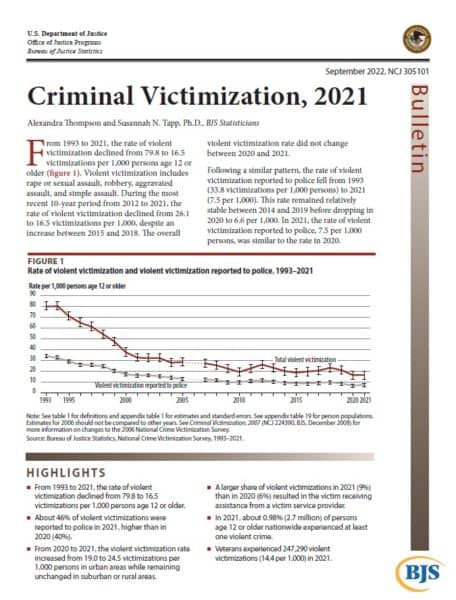
This one covers 2021, and it’s the only reliable nation-wide report on violent crimes that cross racial lines. Other reports may tell you how many blacks or whites were arrested for violence, but it’s almost impossible to find out the races of their victims.
The NCVS tells you. It’s an annual survey of American crime victims who describe every attack they suffered during the survey period, including crimes they didn’t report to the police. This means the results are a very accurate picture of what actually happened, not just crimes the police heard about.
Leaving out the police makes the race data all the more convincing. A lot of people claim – wrongly – that because of “racism,” too many blacks and Hispanics are arrested and too few whites. In the NCVS, crime victims themselves tell you the race of the rapist or mugger. The NCVS doesn’t include murder because it’s a victim survey, and you can’t survey dead people.
The survey sample is carefully selected to mirror the American population, and it is huge. Last year it was 238,043 people or nearly a quarter of a million. For opinion polling, a sample of 1,500 people is a big sample, and that gives a margin of error of about 2-1/2 percent. A sample of 233,000 is gigantic, and gives good results.
So let us turn to the justly celebrated and aptly numbered Table 13, which includes the figures for interracial crime.
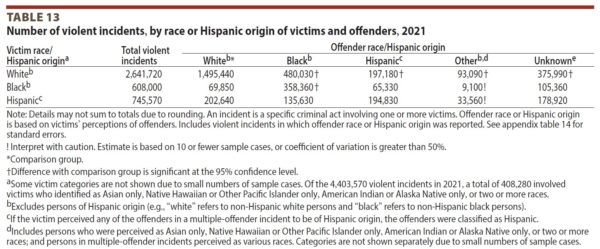
Let’s look at the numbers for white victims. In the second column from the left, you see that in 202,1 there were 2,641,720 cases in which whites were victims of violent crimes. Moving to the right, about a million and a half of their attackers were white, 480,000 were black, nearly 200,000 were Hispanic, and 93,000 were Other. This other category was almost entirely Asians, Pacific Islanders, and American Indians, but they are not broken out separately.
You can also see black victims and the 600,000 or so incidents of black victimization, and who their attackers were, as well as figures for Hispanics. What conclusions does the NCVS draw about race differences in crime?
It manages to be no more controversial than this: “The share of violent incidents involving black offenders (29%) was greater than the population percentage of black persons (12%).”
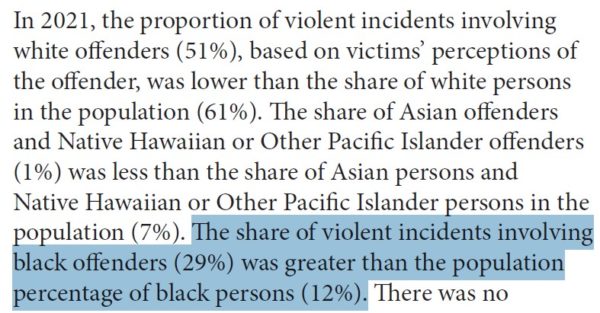
Well, yes, that’s true, but there is a lot more to say than that. For example, we can add up all the white perps on this table, to get a total of 1,767,930 bad guys who attacked either whites, black, or Hispanics.
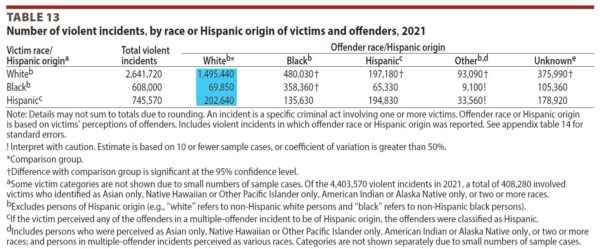
The NCVS says nothing about how many Asians or anyone else whites attacked, but we can calculate the percentages of the victims of whites who were either white, black, or Hispanic, and those three groups make up 91 percent of the population.
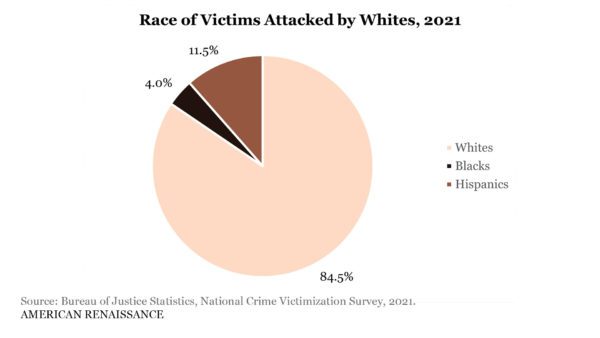
We find that when whites commit violence, they choose other whites 84.5 percent of the time, blacks just 4 percent, and Hispanics 11.5 percent of the time. Violent whites restrict their violence almost exclusively to other whites.
We can also add up the total numbers of black and Hispanic perps and do the same calculations.

We get something very different.
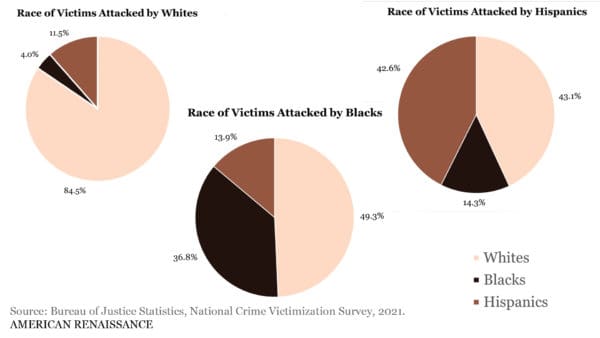
When blacks and Hispanics commit violence, whites are their most frequent victims, followed by their own race, and then the other race. So, it’s all very well to worry about black-on-black violence, for example, but according to the NCVS, there were actually 121,000 more cases of black-on-white than black-on-black violence. Hispanics attacked about 2,400 more whites than they attacked fellow Hispanics.
We can get other interesting numbers. The NCVS says that whites are 61 percent of the US population, blacks are 12 percent, and Hispanics 18 percent. Since we know the number of perps of each race who attacked someone of another race, we can calculate the likelihood that any given person of any of these three groups will attack someone from another group. For blacks and whites, the numbers are shocking. A black person was 35 times more likely to attack a white rather than the other way around. A black person was three times more likely to attack a Hispanic than the reverse, and a Hispanic was 3.3 times more likely to attack a white rather than the other way around.
The Bureau of Justice Statistics reports the data to the public every year.

It takes only simple arithmetic to calculate these figures. But have you ever heard them from anyone else, much less from any mainstream source? No. Journalists are not so stupid they can’t do simple math, but it probably never occurs to them to do these calculations. If it did, they would slit their wrists rather than tell you the results. The media have biases, and one is not to tell you the truth about race.
If a liberal were even aware of these numbers, he would probably say blacks attack whites so often only because there are more whites than blacks – about five times as many, in fact. However, do you think for a moment that the kind of blacks who rape or rob or beat up white people live in places where there are five times as many whites as blacks walking around? This guy, for example.

Of course not. They mostly live around other blacks. They have to hunt for white people to attack. I have no doubt that this lopsided figure – blacks 35 times more likely to attack whites than the reverse – is due, at least in part, to constant media repetition of how bad white people are and how much we owe blacks. That justifies anger, which justifies violence. I suspect it’s also in part due to white passivity. All too many whites don’t fight back, and that also makes them tempting targets.
Thirty years ago, when I first started looking at the NCVS, it included interracial violence rates for specific crimes. Not anymore. For example, you can use these figures from 1994 to calculate that a black was more than 100 times more likely to rob a white than the other way around, and a black men was 34 times more likely to rape a white woman than a white man was to rape a black woman.
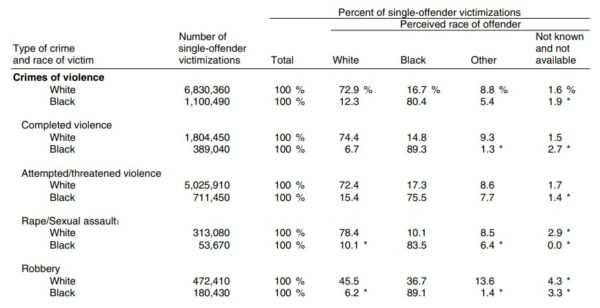
In those days, the NCVS reported multiple-offender crime rates, too. Groups of blacks were nearly 300 times more likely to rob a white than groups of whites were to rob a black.
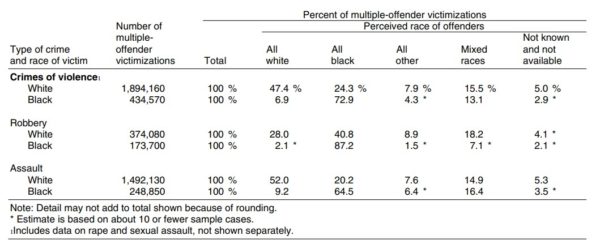
Even then, though, the NCVS did not separately report multiple-offender interracial rapes. I suspect the blacks attacking whites likelihood was very high. The Bureau of Justice Statistics doesn’t make those data available anymore. I can’t imagine why not.
There are some less explosive findings in the NCVS that are worth noting. Because blacks commit so many crimes and often commit them against people of other races, they are 1.8 times more likely to commit violence than be a victim. Whites were 1.4 times more likely to be a victim than an offender. Hispanics were about as likely to be perps as victims. Asians and Pacific Islanders are peaceable. They were 3.8 times more likely to be a victim than an offender.
Needless to say, men are more violent than women. If you ignore the five percent of incidents in which there were both male and female attackers, men committed 77 percent of the violence. Men were seven times more likely than women to be violent.
As is well known, the last two years have seen a big jump in the number of murders, but interestingly, other violent crimes have been flat for the last 10 years, and are way down from the mid-1990s. This graph from the NCVS shows the percentage of Americans, age 12 or older, who were victims of violent crime.
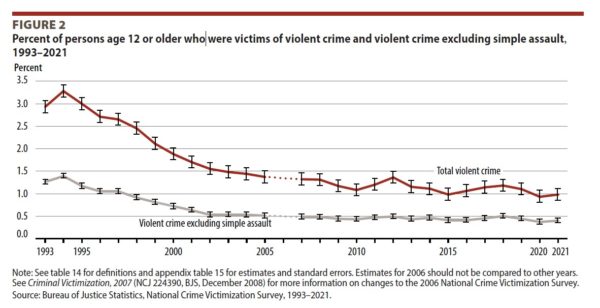
The top line is all violent crime, and the bottom line is everything except simple assault, which includes hitting someone or even just pushing him. There is a lot of that, but it’s the least violent of violent crimes. As you can see over on the left, total violent crime peaked in 1994, when 3-1/4 percent of all Americans 12 or older were victims. That number has dropped to just one third of that, or 1 percent. This contrasts with murder, which has been rising. Here are homicide rates from 1990 to 2020.
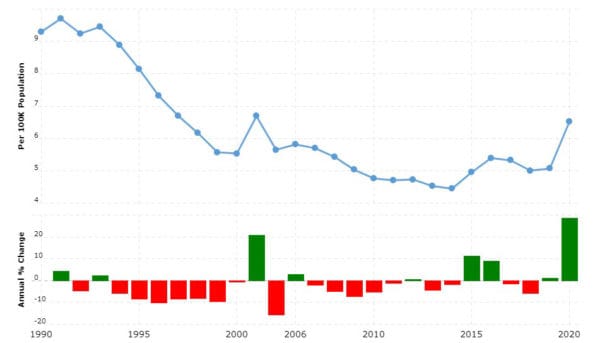
Like the other graph we just saw, the peak was in the 1990s. The jump in 2001 is due almost entirely to the 9/11 attacks. But as you can see, in 2020, while other violent crime was flat, murder rose a record 30 percent. In 2021, it rose another 4-1/2 percent. Why did murder surge while other violent crimes didn’t? I don’t know. But I can say that the record-breaking jump in 2020 and the continuing rise last year were due almost exclusively to more blacks killing each other.
But back to the NCVS. It includes crimes both reported to the police and those not reported, and the percentage reported varies a lot according to the crime. Here are the percentages of crimes reported to the police for 2020 and 2021.
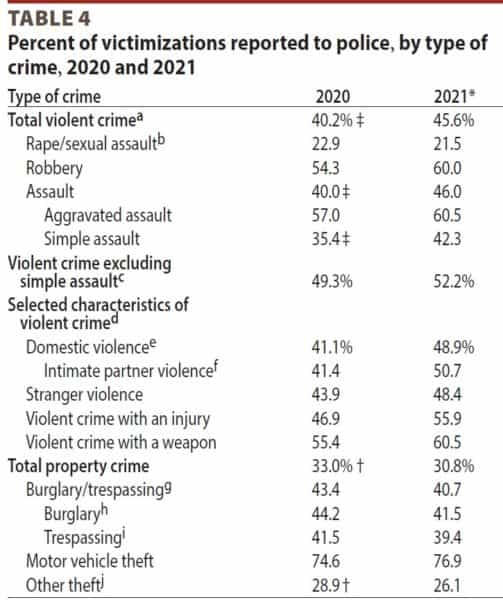
Interestingly, rape and sexual assault is the violent crime least likely to be reported. Why is that? Because sexual assault includes unwanted touching. There is a lot of it, and women report it on a survey but don’t usually call the police for it. You would expect what’s called intimate partner violence not to be reported very often, but police get quite a few calls. This is usually physical violence, not rape. Of all violent crimes, the one most likely to result in a call to police is an attack with a weapon. However, the single crime most likely to prompt a 911 call is car theft. People want their cars back, and they think the police might actually be able to find them.
More on calling the police. Not surprisingly, women are somewhat more likely to report crime: 49 percent to 42 percent for men.
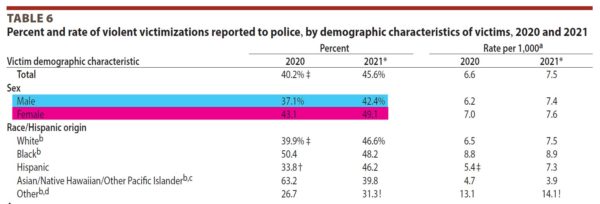
More interesting is the fact that victims of the big three races – in yellow: white, black, and Hispanic – are all almost equally likely to call the police, with blacks slightly in the lead at 48 percent.
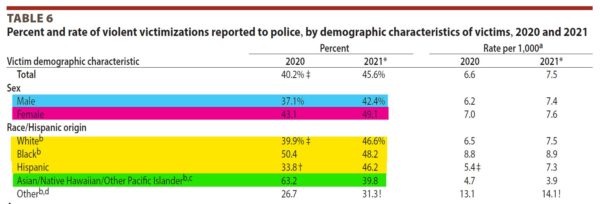
Blacks are supposed to hate and mistrust the police, and Hispanics are supposed to be cowering in the shadows, afraid that ICE will show up if they call 911. It doesn’t look that way. Curiously, it’s Asians who were least likely to call the police in 2021 but most likely to call them in 2020. The samples must be too small to give consistent results.
So, these are the highlights from the latest National Crime Victimization Survey. Again, these data are available to big media, but you can be sure that if you hear anything at all about them, it will be that Joe Biden is doing a great job keeping violent crime under control.
And anything about race? You heard it from me, not from the TV news.















